|
Wildwasser, German Fairs
Sunday, February 25, 2007
If I were to say to you that I had found possibly the best Log Flume in Europe, what would you say? How about if I went on to say that it features two forward drops, a backward one, tunnels, excellent theming, animatronic scenery, and a finale that sees water flying around in every conceivable direction? I don't want to put words into your mouth, but I assume you'd say "That sounds splendid, old chum. Where the dickens will I find it?", a question that leads to the rather unusual answer "It depends on the time of year". 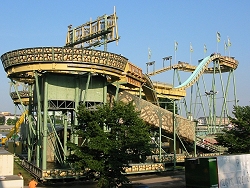 How so? Well, Wildwasser ("Wild Water" for anyone with a god-awful grasp of German) is just one of many jaw-dropping masterpieces that travel the German fair circuit. There really seems no limit to what German showmen can pack into a fleet of lorries and take on tour, and this particular treasure has been living the nomadic life since it left the relative stability of the Mack factory in 1992, and shows no sign of tiring whatsoever. How so? Well, Wildwasser ("Wild Water" for anyone with a god-awful grasp of German) is just one of many jaw-dropping masterpieces that travel the German fair circuit. There really seems no limit to what German showmen can pack into a fleet of lorries and take on tour, and this particular treasure has been living the nomadic life since it left the relative stability of the Mack factory in 1992, and shows no sign of tiring whatsoever.
Now, for anyone unfamiliar with German fairs, the idea of praising a portable log flume may be enough to bring a smirk to your face. If this is the case, I suggest that a few seconds spent watching it in action will be all it takes to have you smirking on the other side of your face (not a pretty sight, I imagine). Standing before this behemoth, it is simply beyond belief that the entire thing is temporary. It would be amazing enough if the ride were only moved once or twice a year, but the idea that it should constantly be on the move is staggering. The trough weaves its way through every gap in the structure, while if you look a massive 98ft into the air, the final two drops form a triple-decker tower that proudly announces the ride's fleeting residency far and wide. 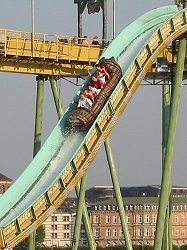 If you wish to take part in this transportable tour-de-force, pull a few Euros from your pocket and head toward the pay box, stopping en route to notice that it is, of course, fully themed, and features an animatronic figure constantly encouraging the crowds to come hither. Prices are extremely reasonable, and after quickly swapping your cash for a ticket, it's time to join the queue. Well, sort of. If you wish to take part in this transportable tour-de-force, pull a few Euros from your pocket and head toward the pay box, stopping en route to notice that it is, of course, fully themed, and features an animatronic figure constantly encouraging the crowds to come hither. Prices are extremely reasonable, and after quickly swapping your cash for a ticket, it's time to join the queue. Well, sort of.
Wildwasser doesn't have a queue in the theme park sense of the word. Sure, it has a pathway full of people that leads to the station, but the ferocious efficiency of the staff, coupled with the vast number of boats the ride can handle, means that all you really do is join a line of people who are continually advancing at a perfectly normal walking pace. Even if the queue area is full to bursting, the throng moves at a speed that means you'd get on the ride no later than if the place were deserted. You almost don't get chance to notice the fact that the station is, again, fully themed, with animatronic figures sitting on the roof, and western lanterns hanging from the ceiling. For the more observant rider, it also bears the name of the ride's owner, Joachim Lowenthal, a man who should be very proud of his charge. Having been "escorted" to your seat (i.e. practically picked up by the arm and slung into the boat), the pace at last slows slightly. From the station, the barrel-themed boat passes the fully themed control box, and heads up the first lift hill, disappearing into the first tunnel as it does so. As you reach the summit, your on-ride photo is taken, and a turntable gets you into position for the backward drop. 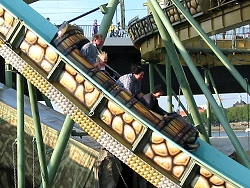 As the boat splashes down, it briefly emerges back into the open air before being consumed by another tunnel, and passing the first of several animatronic scenes, depicting cowboys working in the gold mines of the old west. In the darkness, a second turntable rights the boat, ready to continue about its business. Other scenes depict a minor panic as water floods into the mine, and the strains of moving mine-carts further and further into the pit. It's not a pleasant life for these Old West workers, but they do manage to break the drudgery with the occasional little ditty. Obviously western miners don't take their work as seriously as German log flume operators, or the gold would be pouring out by the bucketful. As the boat splashes down, it briefly emerges back into the open air before being consumed by another tunnel, and passing the first of several animatronic scenes, depicting cowboys working in the gold mines of the old west. In the darkness, a second turntable rights the boat, ready to continue about its business. Other scenes depict a minor panic as water floods into the mine, and the strains of moving mine-carts further and further into the pit. It's not a pleasant life for these Old West workers, but they do manage to break the drudgery with the occasional little ditty. Obviously western miners don't take their work as seriously as German log flume operators, or the gold would be pouring out by the bucketful.
Emerging from the tunnel, we quickly flit past the station, and get paraded past the gathered crowds before engaging the second lift, which marks the start of the ride's towering multi-storey centrepiece. Topping out, the trough does an about turn to the third and final lift. What is highly notable here is that, despite being so short, the effort is nonetheless made to fill this section of the trough with water, whereas many theme parks would be quite happy to save money by using tyre-drives to power the boats around. The third and final lift takes the boat high above the crowd and will invariably give spectacular views of whatever fair it might be attending. Just to remind you that of the ride's "no expense spared" philosophy, the entire section is covered by wooden arches declaring such things as "Too late to turn back!" in various languages. 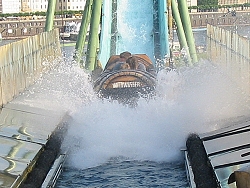 Although not huge, the final drops are more than big enough to keep riders happy, and get them wet enough to be enjoyable without going to excess. The two drops are separated by another mid-air turnaround, during which the boat constantly bobs up and down due to the after effects of the frequent splashdowns occurring behind. Having taken the final drop, the ride's tight footprint forces the boat to hurl itself into the next turn, which gives a feeling more like a Wild Mouse than a Log Flume. Still, with all the drops over, surely all that's left to do is for the boat to bob leisurely back to the station? Although not huge, the final drops are more than big enough to keep riders happy, and get them wet enough to be enjoyable without going to excess. The two drops are separated by another mid-air turnaround, during which the boat constantly bobs up and down due to the after effects of the frequent splashdowns occurring behind. Having taken the final drop, the ride's tight footprint forces the boat to hurl itself into the next turn, which gives a feeling more like a Wild Mouse than a Log Flume. Still, with all the drops over, surely all that's left to do is for the boat to bob leisurely back to the station?
Not so. The trough again parades you in front of the spectators, and suddenly water starts to fly all over the place. First, you pass a water tower that periodically blurts its contents all over the place. Next, a series of ornate fountains arch overhead, only for others take a different line of fire and hurl water into riders' faces. An animatronic cowboy blesses your safe return by singing "Hallelujah", only for a cheeky beaver to poke his head out of a barrel behind him and start squirting water indiscriminately over riders and spectators alike. From here, it is straight back into the unadulterated mania of the station. Amusingly, the normal "theme park rules" go straight out of the window, as staff actively encourage you to be standing and ready to go long before you reach the station, then proceed to physically yank you out of the boat and pack you off in the direction of the ride's beautifully themed photo-stall. This really isn't the best time to stop and chat with your friends about how you found the ride, as the occupants of the next boat will be along in a matter of nanoseconds. 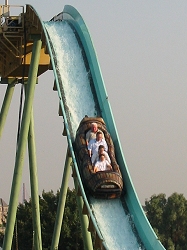 What makes Wildwasser such a fantastic flume ride is its incredible attention to detail. It is immaculately themed, with the entire trough superbly decorated, and all manner of delicate touches. Similarly, while it would be considered a nice touch simply to erect a tunnel to block riders' views of the ride's trucks and cranes, Wildwasser goes a step further, and fills the tunnel with high-quality animatronic scenes, summing up the ride's obvious belief that riders should never be allowed to go more than a few seconds without something grabbing their attention. Suffice to say that theming, even by theme park standards, is excellent throughout, including at night, when the whole ride subtly lit to maintain the wild-west atmosphere beautifully. What makes Wildwasser such a fantastic flume ride is its incredible attention to detail. It is immaculately themed, with the entire trough superbly decorated, and all manner of delicate touches. Similarly, while it would be considered a nice touch simply to erect a tunnel to block riders' views of the ride's trucks and cranes, Wildwasser goes a step further, and fills the tunnel with high-quality animatronic scenes, summing up the ride's obvious belief that riders should never be allowed to go more than a few seconds without something grabbing their attention. Suffice to say that theming, even by theme park standards, is excellent throughout, including at night, when the whole ride subtly lit to maintain the wild-west atmosphere beautifully.
Even more incredibly, despite cropping up in many different cities through the year, the ride was specifically designed to suit one particular fair. Ride it at the Dusseldorf Rheinkirmes in July, and you'll discover why the two turnarounds between the final lifts and drops are at the height they are. They deliberately align themselves with the suspension bridge that runs a few feet from the ride's regular position, giving it an extra way to advertise its presence to passers-by. Such a feature would be praiseworthy of any theme park ride, but to deliberately tailor the ride to a site on which it will spend little more than a week each year is truly staggering. Wildwasser really does go way beyond the call of duty in every way. Whereas it would be reasonable to expect a transportable flume to lack some of the finesse of the theme park rides, Wildwasser is actually more than capable of eclipsing any European theme park flume you'd care to mention. No concession is made to the fact that it is not a permanent ride. No corners are cut, and no easy options taken if they mean compromising the enjoyment of either the rider or spectator. If Wildwasser were at a park, I would give it the highest of praise. The fact, however, that you can ride this masterpiece in the knowledge that the site will sit empty a few days later just makes the whole thing all the more outstanding. Please, do not use our ratings to compare rides head-to-head. They rate only how well this ride meets its own objectives using criteria that may not necessarily be relevant with similar reviews. 
Good points: - This flume would a credit to any park, let alone a fair
- Great theming as well as a thrilling ride
- Not too wet
- Lots of drops
- A great water-filled finale with spectator interaction
Bad points: Labels: GermanFairs, Mack, Recommended, WaterRides
Nemesis, Alton Towers
Saturday, February 24, 2007
This review is scheduled to be re-written in the near future. Please bear in mind that the review may no longer be representative of the ride or our opinion of it Lets briefly reflect on the importance of Nemesis, the 1994 inverted coaster at Alton Towers, Staffordshire: Firstly, this was the first major roller coaster that Tussauds installed at Alton Towers. The 1992 duo (Runaway Mine Train and the Haunted House) deliberately dipped their toes cautiously into the large pool that SW3 (soon to become Nemesis) dived straight into. Nemesis was another indication of what direction Tussauds wanted to take Alton Towers. Unsurprisingly, the parks' operators reported healthy attendance. 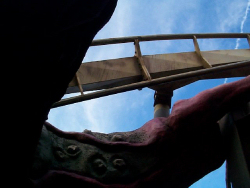 Furthermore, Nemesis was the catalyst of many peoples' enthusiasm towards coasters. It shared the 1994 limelight with Blackpool's Big One with Drayton Manor's Shockwave edging in stage right. Unsurprisingly, the Roller Coaster Club of Great Britain reported record enrolment into the club of enthusiasts. Furthermore, Nemesis was the catalyst of many peoples' enthusiasm towards coasters. It shared the 1994 limelight with Blackpool's Big One with Drayton Manor's Shockwave edging in stage right. Unsurprisingly, the Roller Coaster Club of Great Britain reported record enrolment into the club of enthusiasts. At the risk of being immortalised in granite on the fourth plinth in Trafalgar Square, John Wardley stepped forward to share kudos for a true British phenomenon. Reported to be the "World's most intense roller coaster experience", it took only a couple of circuits before the ride proved too much to a super-fit Gladiator who was actually ill (much to the delight of Alton's marketing department). Nemesis broke the mould in many ways. Designers had to use awkward criteria set by the council to hide Nemesis from outside of the park. Extensive excavation made it possible for the ground-hugging ride to be built predominantly below ground level which unquestionably improves the sensation throughout. The existence of Nemesis isn't apparent until you're virtually at the entrance. Fictionally, a large hole has been torn into the Staffordshire landscape in which the monster (station) is pinned down by hundreds of tons of steel (the ride). Very little track is visible, but the impact is spectacular never the less as the train explodes through a tight helix disappearing deep down into the rocky abyss below. 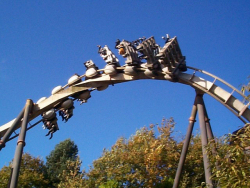 The queue is over-rated and a shadow of its former self. Where it formerly took you around the precipice of the 90ft deep crater, you are now directed to the left away from the ride and through a copse under the lift. The queue is over-rated and a shadow of its former self. Where it formerly took you around the precipice of the 90ft deep crater, you are now directed to the left away from the ride and through a copse under the lift.
Despite the pathway being cobbled in chewing gum and cigarette buts in the puddles in the holes torn into the wall of the graffiti-covered station, your attention is drawn to the vertical loop where track drops deep underground before exploding into an arc above your head. The station is very small and you are left to your own devices. Walk right for the front, or left for the remainder of the train. Back right is to be highly recommended should you not want to do the front. Nemesis is all about destroying your sense of well-being. You can imagine designers working to a checklist of terrifying effects: 1. Ensure train heads towards and over queue-line at every available opportunity. Check.
2. Use buzzwords like "fright" and "intense" in dialogue and on signs. Check
3. Compose dramatic and harrowing soundtrack. Check
4. Use a haunting shade of sepia to colour the attraction. Check Everything is there to make new riders feel about an inch tall. The ride gets off to a re-assuring start once you sit in the comfortable, body-hugging seat and pull down the substantial over-head restraint. The lift follows the contours of the ground below, so at the top, instead of towering over the park and plunging into a near-vertical downward spiral, a simple 90-degree turn smoothly whips you off the lift into what can only be described as a gentle ramp. 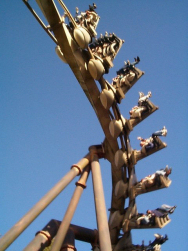 Ironically, following the ground down a shallow drop gives a great sense of speed. Instead of quickly accelerating up to 50mph, rocks, grass and the pink water below soon become a blur as you get faster - faster... before you dip sharply down over a line of ducking queuers before pulling skyward into a sky-scraping barrel roll. From following the ground to rolling high through the air is a contrast only a few rides can pull off. Ironically, following the ground down a shallow drop gives a great sense of speed. Instead of quickly accelerating up to 50mph, rocks, grass and the pink water below soon become a blur as you get faster - faster... before you dip sharply down over a line of ducking queuers before pulling skyward into a sky-scraping barrel roll. From following the ground to rolling high through the air is a contrast only a few rides can pull off.
The force of Nemesis soon becomes apparent as you drop from the barrel roll into a tight, highly banked downward helix. As your feet follow the fence, your arms fight the force as the ride burrows itself deep down into the ground, pulling up at the last moment and rolling clumsily through an inline twist. Riders curl up into a foetal position as the train barely misses the station building and arms and legs head in all directions towards the bloody tentacles and body of the Nemesis monster. With heartbeats heading skywards, you follow a waterfall upstream into a stall turn. A sharp turn flattens out at the top before sharply pulling you downward again deep down into the ground. Take a breath as you head towards the mucky water below before the train is pulled away from a wall and into an incredibly forceful vertical loop dropping out past a waterfall into a tunnel the size of a rabbit hole, exploding out of the ground into a swooping turn before being tugged down faster than gravity under a bridge. As you head towards the wreck of a Mushroom Cloud Tour bus you are pulled away at the very last moment through one of the best surprise inversions ever - a ground-hugging barrel roll that once again sends you through a dark tunnel into a final turn before snapping upright into the brakes. 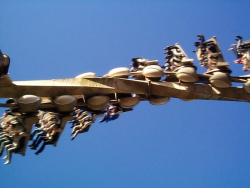 Nemesis is not the most intense coaster in the world, but it does have some very extreme, G-happy elements that make the ride stand out. Nemesis is not the most intense coaster in the world, but it does have some very extreme, G-happy elements that make the ride stand out.
Nemesis starts slowly, evolving into something that becomes a relentless thrill, continually getting faster and wilder as each foot of track is conquered. Each element becomes more and more extreme and the feeling of recklessness is quite exquisite as the ride plays with the surrounding scenery to great effect. Although often considered a forte, should you not be familiar with the cumbersome 20-minute legend, the theming is weak and confusing. Sole onus falls upon the station, themed as the mighty Nemesis monster, a wicked alien bent on revenge after being awoken from its slumber. To those who haven't heard the legend, the rivers of blood look like pink lemonade, the station appears a non-descript mess of sprayed concrete and chewing gum and the scrap metal strewn throughout irrelevant. Whilst under the ride is a comprehensive labyrinth of pathways for the ride to interact with, the messily implemented Virtual Queue has resulted in most of this being closed off and rendered impassable to those not riding - a big selling point when the ride first opened. 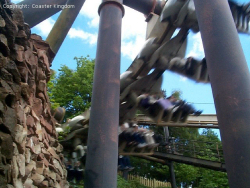 Focusing on the ride alone, highlights are well paced throughout and include the powerful first helix, the sharp and feisty vertical loop and finishing well with the surprise barrel roll. Focusing on the ride alone, highlights are well paced throughout and include the powerful first helix, the sharp and feisty vertical loop and finishing well with the surprise barrel roll.
Foot-choppers play an important role in the ride, which as well as making the feeling of ever-impending doom so evident, makes the ride seem twice as fast as it is. Getting faster every year, Nemesis is really showing its true colours now. Whilst it never fails to deliver the inline twist has become too fast and lumbering to really have the impact it originally did. Slowly accelerating like Zorba's Dance and with pacing as impeccable as a seasoned line dancer, as a coaster, Nemesis will never fail to deliver. But the overly complex theming, grubby presentation of the ride and the inaccessibility of half of the pathways due to Virtual Queuing weaken the experience of what is otherwise a contemporary classic. Please, do not use our ratings to compare rides head-to-head. They rate only how well this ride meets its own objectives using criteria that may not necessarily be relevant with similar reviews. 
Good points: - Truly original and way ahead of its time in terms of ride, theme and style
- Complex back story and legend to go with it
- Lavish theming including the monster, abandoned buses and machinery
- Extremely intense coaster, very forceful but still smooth even into its second decade
- Impeccable pacing despite the size of the coaster
- The tunnels and caverns add infinitely to the ride experience with excellent foot-chopper sensations throughout
Bad points: - Can often look tatty, although the park have spent time on improving the appearance of the ride
- Story is perhaps too difficult to understand the theme if you're unaware of the legend
Labels: AltonTowers, BandM, Coaster, Recommended
Eurostar, German Fairs
Friday, February 23, 2007
No matter how hard you try, you simply can't prepare yourself for your first visit to a German fair. However high your expectations, I defy anyone not to spend their entire visit uttering the words "How can that thing travel?" every thirty seconds or so. Even when you should be used to it, there are some rides that retain this sense of mystique and wonder, and none more so than Eurostar. This epic tangle of dark purple track would be a jaw-dropping sight at any theme park, but the very idea that the whole thing is temporary simply catapults the ride over the edge of believability. As if that weren't enough, it also just happens to be one of the most frantic, intense, and exhilarating coasters you could ever wish to ride. Debuting in 1995, just eighteen months after Alton Towers' Nemesis became Europe's first inverted coaster, Eurostar is a testament to the fierce rivalry that exists between German showmen. Indeed, the idea that anyone ever seriously thought about making a travelling inverter of this size is amazing, but to then make it a reality is quite simply mind-blowing. 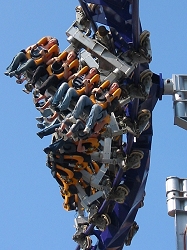 Until Eurostar came along, Germany's tradition of large travelling coasters had stalled slightly. Anton Schwarzkopf, the mastermind behind the likes of Thriller and Dreier Looping, had fallen ill. His last major travelling coaster was 1989's Olympia Looping, while the only other major coaster to appear in this respite had been 1992's enclosed family ride, "Magic Mountain" (now "Star World"). Oscar Bruch, Germany's most famous showman, had been touring his two large coasters, Thriller and Alpina Bahn, for over ten years, and wanted to add something new to his line-up. Until Eurostar came along, Germany's tradition of large travelling coasters had stalled slightly. Anton Schwarzkopf, the mastermind behind the likes of Thriller and Dreier Looping, had fallen ill. His last major travelling coaster was 1989's Olympia Looping, while the only other major coaster to appear in this respite had been 1992's enclosed family ride, "Magic Mountain" (now "Star World"). Oscar Bruch, Germany's most famous showman, had been touring his two large coasters, Thriller and Alpina Bahn, for over ten years, and wanted to add something new to his line-up.
Meanwhile, B&M was setting the theme park world alight with their new inverted coasters, and so this seemed the obvious direction for Bruch to take. The trouble was that few people were willing or able to take on the massive task of a full-size travelling inverter. As a result, the project came to involve people and companies from all over the continent, an arrangement that provided the inspiration for the ride's eventual name. Officially, the ride comes from Intamin, although much of the work was sub-contracted to Giovanola, a company that had worked with B&M and would later go on to build coasters under their own name. As for the design, this came from the then-relatively unknown Werner Stengel, who had worked extensively with Anton Schwarzkopf on previous travelling coasters. In addition, the Bruch family were also heavily involved with the design, both in terms of how they wanted it to ride, and how the massive structure could be made easier to transport. It's worth pausing to think exactly what considerations needed to be made in designing this ride, as they go far beyond anything a theme park ride would need to worry about, and make it easier for us to appreciate what a huge accomplishment Eurostar is. 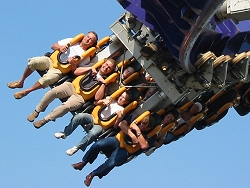 Firstly, the ride needed to be comparable to previous travelling coasters both in terms of ground space, and the time required to build and dismantle. As such, the ride used a similar "plug and socket" structure to the Schwarzkopf coasters. This allowed the ride to be pieced together with minimal fuss, allowing it to be booked onto as many fairs as possible each year, while minimising the need to hire local people to help build and dismantle the ride at each location. Firstly, the ride needed to be comparable to previous travelling coasters both in terms of ground space, and the time required to build and dismantle. As such, the ride used a similar "plug and socket" structure to the Schwarzkopf coasters. This allowed the ride to be pieced together with minimal fuss, allowing it to be booked onto as many fairs as possible each year, while minimising the need to hire local people to help build and dismantle the ride at each location.
Secondly, while the structure needed to be strong enough to cope with the enormous stresses involved, it needed to be slender enough to pack onto as few lorries as possible in order to reduce the transportation costs. It's no use having a world-class coaster if you have to charge people more to ride it than they're willing to pay. Thirdly, anyone who has visited a busy German fair will know that the crowds can be colossal. Indeed, the top German fairs attract more people in their 1-2 two week run than most major theme parks get all year. As such, a major coaster needs to have an astronomically high capacity, as you obviously want to get as many people through the gate as the fair's opening hours allow. As such, Eurostar needed to match the ferocious capacity of Schwarzkopf's legendary crowd-crunchers, and is capable of running four 28-seat trains at peak times, forcing staff to maintain loading times far faster than most theme park coasters. Fourthly, the ride simply needed to look good. Remember, the ride operates in a pay-per-ride environment, and needs all its elements to be clearly visible in order 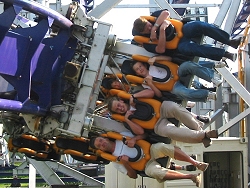 to entice spectators to the paybox. Again, you could have the greatest coaster on the planet, but if it doesn't grab the interest of passers-by and make them want to open their wallets for tickets, it will fail. Schwarzkopf's travelling coasters were a masterclass of "staging", with the lift hill and bigger drops at the back of the ride, and other major elements, such as inversions, perched in the foreground, and often right above the paybox for maximum visual impact. to entice spectators to the paybox. Again, you could have the greatest coaster on the planet, but if it doesn't grab the interest of passers-by and make them want to open their wallets for tickets, it will fail. Schwarzkopf's travelling coasters were a masterclass of "staging", with the lift hill and bigger drops at the back of the ride, and other major elements, such as inversions, perched in the foreground, and often right above the paybox for maximum visual impact. Finally, and most obviously, it has to be a good ride. It doesn't take a genius to work out that you can at least double your revenue by offering a coaster that people will want to re-ride. If you get off the ride without having enjoyed it, that's one more ticket that will go unsold. So there you have it. Versprung durch Technik. Would you fancy trying to design a coaster within these limitations? No, and neither did a lot of other people. It was immensely brave of Werner Stengel to accept the challenge, especially as he was not the legendary figure he is today. Indeed, Eurostar was arguably the first time that Stengel would be regarded as the "star" designer, rather than remaining an anonymous back-room boffin. Despite opening late at its first few fairs, Bruch's battalion of staff soon managed to find ways of building the ride in less and less time, and using less and less trucks. Nowadays, the whole process goes with military precision, and the ride is always ready for business when the fair opens. 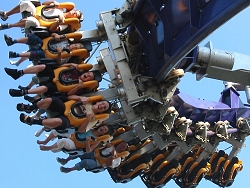 So, we find ourselves standing before the mountain of steel that is Eurostar. Certainly, the need to look good has been met. The ride is staged beautifully, with the twisted first drop in the background, the huge loop dominating the mid-ground, and a lightning fast in-line twist being performed above the paybox and queue. Keep watching, and you'll see the train plough through the twin corkscrews that form one of the ride's many high-speed, high-drama, high-G highlights. At night, the subtle floodlighting reflects beautifully on the structure, giving the ride a gloriously intimidating aura as the trains blur past in all directions. So, we find ourselves standing before the mountain of steel that is Eurostar. Certainly, the need to look good has been met. The ride is staged beautifully, with the twisted first drop in the background, the huge loop dominating the mid-ground, and a lightning fast in-line twist being performed above the paybox and queue. Keep watching, and you'll see the train plough through the twin corkscrews that form one of the ride's many high-speed, high-drama, high-G highlights. At night, the subtle floodlighting reflects beautifully on the structure, giving the ride a gloriously intimidating aura as the trains blur past in all directions.
At the paybox, a ticket is received for less money than you might reasonably expect, and it is time to join the fast-moving queue. As with many German fair rides, "queue" is not really the appropriate word, as it tends to move at close to walking pace, and so what might look like an hour's queue dissolves in minutes. As you approach the station, prepare to be in awe of the staff. Usually, when we praise ride staff, it is for their friendliness, but here it is for the ferocious efficiency with which they operate the ride. Forget about politeness, if your group can fill those last few seats, prepare to be virtually grabbed by the neck and thrown into the train. For theme park devotees, this will be yet another indication of the fact that the German fairs are a whole new world, with an unprecedented sense of haste and urgency. The trains themselves resemble stripped-down B&M cars, with none of the niceties that we associate with Walter and Claude's luxury vehicles. No seatbelts, no moving floors, just the bare minimum needed to hold you in your seat, and to keep the trains running like clockwork. Indeed, when you've ridden Eurostar, the B&M inverters suddenly seem needlessly complex. 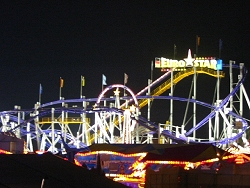 At the sound of a hooter, the train charges away to the rear of the ride, where it engages the deafening lift hill. From here, we are thrown straight into an inverted equivalent of the famous Schwarzkopf twisting first drop, and into the vertical loop with all the speed and fury of a rampaging rhinoceros. Front seat riders will get the first of many scares, as pieces of structure fly past at a proximity that makes them half-expect the ride to trim their toenails for them. At the sound of a hooter, the train charges away to the rear of the ride, where it engages the deafening lift hill. From here, we are thrown straight into an inverted equivalent of the famous Schwarzkopf twisting first drop, and into the vertical loop with all the speed and fury of a rampaging rhinoceros. Front seat riders will get the first of many scares, as pieces of structure fly past at a proximity that makes them half-expect the ride to trim their toenails for them.
No time to recover, as the train barges into an overbanked turn, ripping wildly to the left as it prepares to soar across the station roof and into the ferocious in-line twist. As with much of the ride, it may lack the grace of the B&M inverters, but what it lacks in finesse, it more than makes up for in sheer aggression. No coaster, Nemesis included, makes you feel so puny in the face of a rampaging typhoon of a ride. Tearing out of the inline twist, it's time to hit the first set of brakes. Now, it's conventional to bemoan the braking of coasters, but Eurostar is slightly different. While the brakes need to be there to allow the operation of so many trains, the fact that the train slows to a crawl actually serves as a well-earned breather, before hurtling back into the unadulterated mania of the ride. Indeed, if the train were allowed to charge on at full speed, it's doubtful that the riders would live to tell the tale. The next section simply oozes quality. After a swift drop, the train curls straight into two consecutive corkscrews, both tighter than you would ever think possible at this speed. With its passengers thoroughly disorientated, the train finds itself needing to perform a turn that may well rank as the most intense piece of coaster track on Earth. If you are still conscious enough to know what is going on, this near-hairpin turn pulls enough G-force to send blood rushing straight to your feet, a sensation quite unlike anything other coasters can offer. 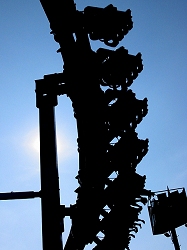 Into another brake run, and the train again slows to a crawl. With all the inversions over, is this the point where the ride calms down? Not a bit of it, for Eurostar has one last trick up its sleeve. Twisting to the right, the track drops into a helix. The speeds get higher and higher, and the turn gets tighter and tighter, and soon riders are feeling the kind of G-force make them fear that the fillings are going to be ripped from their teeth. After what seems like an eternity, the train is effortlessly spat into the final brakes, which accurately simulate the feeling of being smashed into a badly placed brick wall. Into another brake run, and the train again slows to a crawl. With all the inversions over, is this the point where the ride calms down? Not a bit of it, for Eurostar has one last trick up its sleeve. Twisting to the right, the track drops into a helix. The speeds get higher and higher, and the turn gets tighter and tighter, and soon riders are feeling the kind of G-force make them fear that the fillings are going to be ripped from their teeth. After what seems like an eternity, the train is effortlessly spat into the final brakes, which accurately simulate the feeling of being smashed into a badly placed brick wall.
The organised chaos of the station throws you onto the exit platform, and down an exit path that continues the intimidation by sending trains roaring past at furious speeds. This primeval language of roars and screams can only translate to a challenge to re-ride. Eurostar is devastatingly awesome. No ride can match it for maniacally grabbing riders by the throat and taking them to the limits of endurance. If you are looking for a passive, calming experience, look elsewhere; Eurostar caters for those of us who like a coaster to show no mercy, to seize us and challenge us to battle it out, to prove our mettle. Once you have ridden Eurostar, it is difficult not to snigger at the thought of Alton Towers advertising Nemesis as "The world's most intense roller coaster experience". Compared to Eurostar, Nemesis is about as intimidating as a newborn kitten. There is, however, one accusation that many riders levy, and it one that that I intend to rebuke with every breath in my body. Ladies and gentlemen, Eurostar is not - I repeat NOT - too rough. Not by a long chalk. Let me explain: Sure, it's not smooth in the B&M sense of the word, but that certainly isn't something that should be seen as negative. If anything, its undoubted brutality simply serves to emphasise the sense of incredible dominance the ride has over its pray. Even in the back seats, where the G-forces are enough to totally disorientate riders, the experience never crosses the line into discomfort. When you ride Eurostar, you simply have to do exactly that - RIDE it, in the way you would a bucking bronco. There really is no point in sitting impassively in your seat and expecting to glide through its impossibly tight corners, as you'll come off second best. Eurostar is fierce, ferocious, wild, untamed and menacing. As a rider, it demands that you are prepared to do battle, and for those who are, the effort is rewarded tenfold, as the ride will get the adrenalin pumping in a way that few other coasters can ever hope to match. As someone who loves a ride that makes it clear who wears the trousers, I firmly believe Eurostar to be everything you could possibly want a coaster to be, and is one of the greatest rides you could ever hope to find. It has no airs or graces, it doesn't mollycoddle riders, it just does its job of terrorising hapless riders, and does it to perfection. It exudes a tangible aura of pure aggression, and never lets you forget that you are on its territory and have to play by its rules. Do that, and you'll soon realise that the real king of wild-and-furious inverted coasters does not reside in a Staffordshire crater, but is instead constantly prowling around the showgrounds of Germany. Long may it reign. Please, do not use our ratings to compare rides head-to-head. They rate only how well this ride meets its own objectives using criteria that may not necessarily be relevant with similar reviews. 
Good points: - Utterly ferocious
- Some of the most intense elements ever built
- Impeccable operation and capacity
Bad points: Labels: Coaster, GermanFairs, Intamin, Recommended, Star
Batman: La Fuga, Parque Warner
Wednesday, February 21, 2007
"No policeman's going to give the Batmobile a ticket."
"This money goes to building better roads. We all must do our part." These are words of wisdom from the mouth of Batman, a superhero quite unlike any other. Batman has always been famous for his lack of super-powers and his inability to fly. He has made it fashionable to go to the scenes of crime in a Batmobile, lecture robin about the use of English ("good grammar is essential, Robin") and to use his quick wit and bare fists to fight crime. 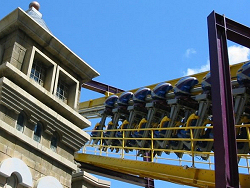 The same can be said of La Fuga. Whilst other rides use new technology and gimmicks to their advantage, Batman: La Fuga uses a tried and tested layout on a tried and tested design and delivers as much, if not more that the less contemporary 21st century gimmick coasters. The same can be said of La Fuga. Whilst other rides use new technology and gimmicks to their advantage, Batman: La Fuga uses a tried and tested layout on a tried and tested design and delivers as much, if not more that the less contemporary 21st century gimmick coasters.
We pick up the story at Arkham, the fortified home for the criminally insane. Crime scene tape is wrapped around the entrance arch as you go through a small garden outside the large asylum. As soon as you walk through the doors of Arkham, you can feel that something is wrong. Arkham was home to some of Gotham City's most colourful crooks such as Catwoman, Riddler and Joker, all equally hell-bent on escaping - all equally sucessful. Walking through the dank corridors of Arkham, this ‘home for the criminally insane' is clearly a prison with knobs on. Every corridor is patrolled by CCTV cameras, walls are grey breezeblocks and urine soaked cells hardly give the Hilton Hotel a run for their money. 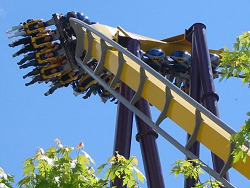 An infestation of ivy follows crawls the length of the corridor, and graffiti with such unsettling comments like "So long, losers!" ring alarm bells that you duly ignore. An infestation of ivy follows crawls the length of the corridor, and graffiti with such unsettling comments like "So long, losers!" ring alarm bells that you duly ignore.
You pass the lockers with such tongue in cheek contents such as cattle prods and chain and balls before entering a social room. Chairs and tables are overturned on the floor, and a guard has been frozen to death behind his unfinished game of chequers. The trains are shorter than standard with seven cars of four as opposed to eight. Many of B&M's smaller, more forceful rides of late are a car short much like Nemesis Inferno at Thorpe Park. You take your seat in a normal B&M inverter train upholstered with dark blue seats and striking yellow restraints before bars are checked and the floor silently drops away as the train advances onto the short 100ft lift. If swooping drops don't go to extremes, they are normally something I don't really care for. Batman's offers a nice sensation, not dissimilar to toothpase going down a plughole. It is a steep drop, but the banking is what makes it feel so special. 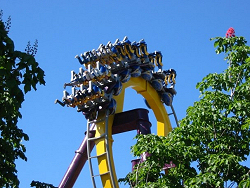 Without due hesitation, a tight climb sends you into a small vertical loop offering an absolutely impeccable mixture of forces and visuals even at the top. Without due hesitation, a tight climb sends you into a small vertical loop offering an absolutely impeccable mixture of forces and visuals even at the top.
If you were worried about your feet hitting the shrubbery below, the train tears away from the ground, cavorting towards the stained masonry and tiled roof of Arkham before rolling clockwise through an inline twist. The inline twist goes to show that you can have a forceful element that pins your head to the side without going anywhere near the town of Rough. Completing this remorseless hat-trick of inversions and perfectly complimenting the first, a vertical loop. 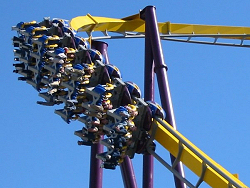 This string of three inversions represents one of the best starts to any coaster I've ridden. It isn't a one-trick first drop, but three well timed inversions which hit you unremittingly one after the other. This string of three inversions represents one of the best starts to any coaster I've ridden. It isn't a one-trick first drop, but three well timed inversions which hit you unremittingly one after the other.
No rest for the peacekeeping superhero as the 28 riders are dragged kicking and screaming into a tight anti-clockwise helix. This spiral follows the line of the final turn into the brakes. As every support you pass gets closer and closer, instinct insists you pull your legs up, but the powerful G-forces never afford you this opportunity. As the helix ends, you gracefully swoop around a 180-degree bend before dropping into an abrupt corkscrew, another perfect blend of forces, never compromising your comfort before a tight turn pulls you away from a pair of gargoyles and the wall of Arkham Asylum before you are forced down into a trench, sharply yanking your legs away from the concrete sides before you explode into a final corkscrew, finishing by making a final 180-degree turn onto the sharp brakes. 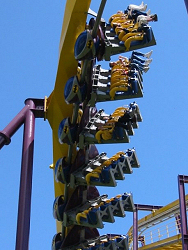 I'll start off with my complaints about Batman: It's quite a short ride. I'll start off with my complaints about Batman: It's quite a short ride.
Now that my complaints are out of the way, baton down the hatches Gotham City, as here comes a tidal wave - a veritable tsunami of praise. Actually, having ‘complained' about the length of the ride, the faultless pacing and merciless consistency of intensity is probably down to the undiluted length of Batman - a ride's intensity can become watered down by length. Batman is a good ride because the start doesn't outshine the rest, and the beginning isn't just track leading into the spectacular finale. It is consistently fast, persistently intense and simply doesn't let up until the brakes say so. Overlooking the intensity of the ride, there's no shortage of stand-out moments. Like Nemesis, it performs well to the spectator, and at one point shadows the pathway below (inline twist). Meanwhile, on the ride the structure plays an important roll in the illusion of foot-choppers, and going beyond what the original Batmen offer, the buildings are also used at least twice to fool you into thinking that you'll be going through one of the windows. 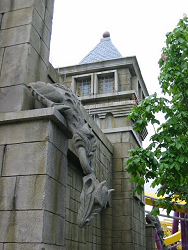 The theming is the icing on an utterly delicious cake. The ride never relies on the theme, but the theming fuses so well and really sets off the whole attraction. Never are you brainwashed by tedious pre-shows and videos that you miss when there is no queue. Everything is real, and makes what would be an otherwise uneventful walk into part of the attraction. Going against what seems to be an unwritten decree, the theme is also carried through right until the end, and isn't forgotten as soon as the train hits the brakes. The theming is the icing on an utterly delicious cake. The ride never relies on the theme, but the theming fuses so well and really sets off the whole attraction. Never are you brainwashed by tedious pre-shows and videos that you miss when there is no queue. Everything is real, and makes what would be an otherwise uneventful walk into part of the attraction. Going against what seems to be an unwritten decree, the theme is also carried through right until the end, and isn't forgotten as soon as the train hits the brakes.
Batman: La Fuga is a true thoroughbred coaster. Many rides use advances in technology to their advantage, but Batman relies solely on a dynamic layout and tremendous pacing to thrill. Looking at the layout alone, Batman is hard to beat, but the theming just prolongs the enjoyment of an already faultless coaster. Please, do not use our ratings to compare rides head-to-head. They rate only how well this ride meets its own objectives using criteria that may not necessarily be relevant with similar reviews. 
Good points: - A highly imaginative theme centred around the Arkham Asylum and a incredibly intense inverted coaster
- Although a clone, it is unique to Europe and offers a well paced and punchy ride
- The ride quality is easily of the same standard as Nemesis
Bad points: - Despite the excellent theming, the station theming is quite bland, and some of the area that the ride takes place in is also plain
- Some might argue that it is too short. But they're wrong
Labels: BandM, Coaster, ParqueWarner, Recommended
|